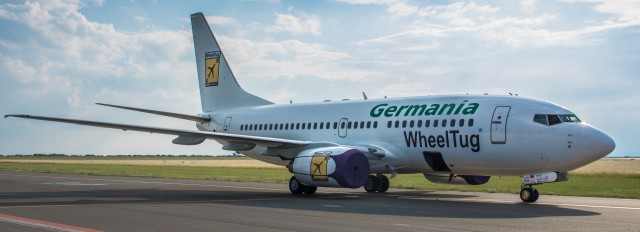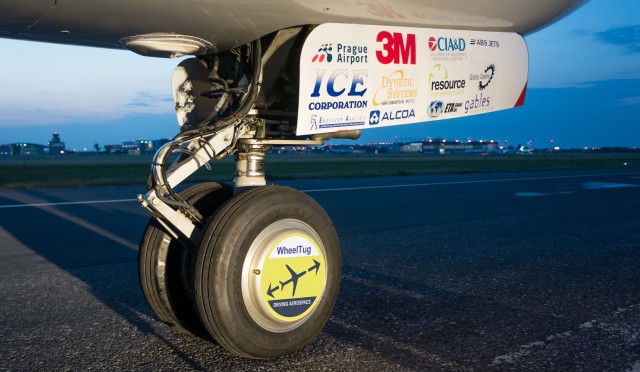
WheelTug testing at Prague Airport using a Germania 737-700 in June, 2012. Yes, it’s moving!
Courtesy: WheelTug
You may have read my recent report on the Honeywell/Safran Electric Ground Taxi System, or EGTS. But as we’ve seen countless times with many technologies, there’s rarely just one solution to a challenge. We’ve had the 707 & DC-8 duo, L-1011 & DC-10s, 737 & A320s, PCs & Macs, iThingys & Everything Else… you get the idea. Interesting, though, that the market usually settles down to 2 options. So it should be no surprise that there’s another E-Taxi system, one that takes a different approach to meeting the same objectives of saving fuel, time, and other operational costs.
Gibraltar-based WheelTug decided to figure out a way to power the nose gear in their E-Taxi solution, and not the main gear. Their reasons? Easier and quicker installation; no interference with braking and anti-skid systems; shorter cable runs to the equipment bay under the cockpit; and it’s lighter, on the single nose gear rather than two main gear. But there isn’t much space available on the nose gear and in the wheel well. To make it all work, WheelTug looked to an old idea updated with new technology – the “wheel-hub” electric motor.

WheelTug wheel-hub electric motor installed on the nose gear of the 737-700 test aircraft. Cool hubcaps.
Courtesy: WheelTug
The concept dates way back to the late-1800’s. The first patent for a fully-incorporated wheel-hub motor was granted in 1890. Now, with new technologies, materials and manufacturing methods, we’re seeing these motors in e-bicycles, and concept cars and trucks. WheelTug did a “proof-of-concept” test back in 2005 on a Boeing 767.
That test used a big, external motor system attached to the nose gear, but it was able to move the almost-fully loaded 767. Once the concept was proven, WheelTug went to work to develop the technology to fit the motor system into the nose wheel hub. They’ve got dozens and dozens of patents for their tech.
Airlines are certainly on-board with the concept. WheelTug has reservations for over 570 delivery slots from 11 airlines. The customers include KLM, Alitalia, El Al, Israir, Icelandair, Jet Airways and Air Berlin. Installations will be on 737NG, A320 and 737MAX aircraft. WheelTug doesn’t yet have any reservations for wide-body aircraft installs, but I’m told there “are several under discussion.” They expect to have the system in operational service by the end of 2014, into the 1st quarter of 2015.
I’m Canadian, and I’ve experienced some intense winter weather and the flight delays that go along with major snowstorms. So I asked WheelTug CEO Isaiah Cox how well the system would work at heavy-snowfall airports, such as YUL and ORD. He answered, “It will depend on the specific conditions. There will be some situations in which WheelTug will not work as well as a tug, and we will be detailing those in the runup to EIS (Entry Into Service). But it will be a very small percentage of operating states.” WheelTug has already tested the system on snow and ice, and have designed it so that wheel-lift and tow-bar tugs can still be used on equipped planes. And of course, crews can always spool up the engines if they need an extra push.
Click HERE to watch the WheelTug 737 demo at Prague Airport.
So there you have it. Another duopoly working on the same objective. WheelTug and EGTS. Powered nose wheel vs powered main gear. Will one prove to be the market leader? Does one system seem to have an advantage over the other? What do you think E-Taxi will do to airport and ramp operations? Tell us – leave a comment.
 |
This story written by… Howard Slutsken, Correspondent.
Howard has been an AvGeek since he was a kid, watching TCA Super Connies, Viscounts and early jets at Montreal’s Dorval Airport. He’s a pilot who loves to fly gliders and pretty well anything else with wings. Howard is based in Vancouver, BC. |